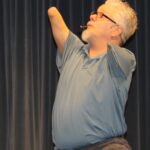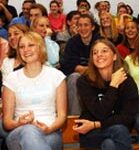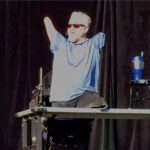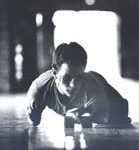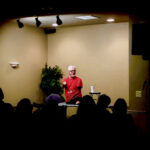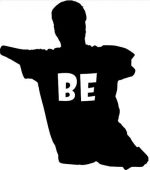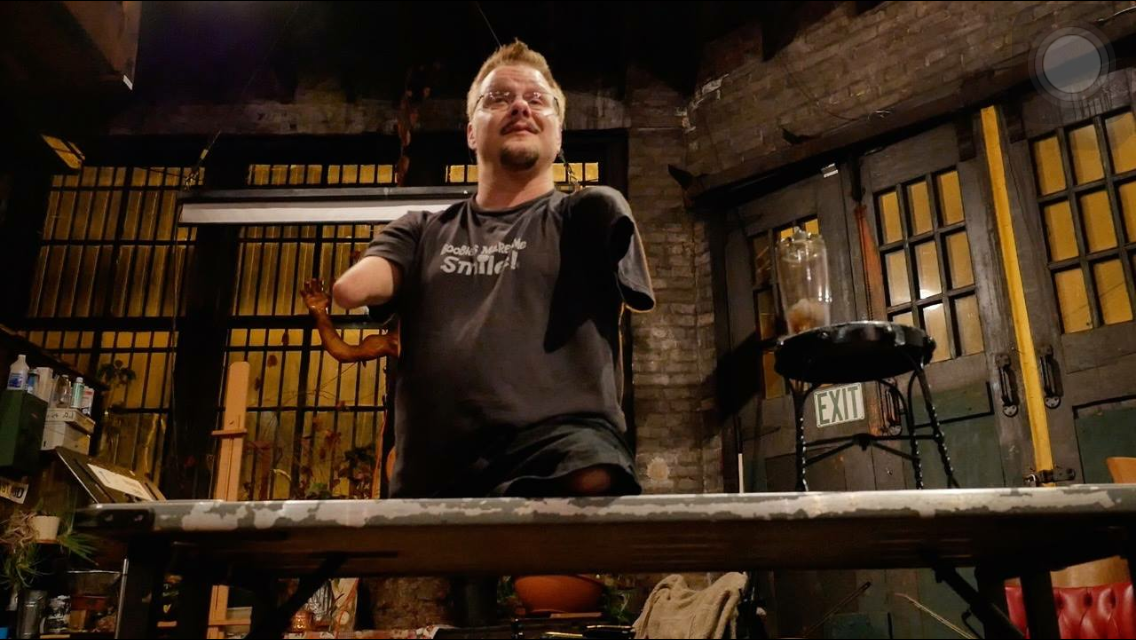The following is an article written by Colleen Garber, of the Huntington County (IN)TAB and reproduced here with their permission. The original appeared in the March 15 edition of The Huntington County (IN) TAB.
No arms, no legs, no limit on what this hero ‘can do’
By COLLEEN GARBER
Most people operate on the baseball theory. They give 110 percent for roughly three attempts. If it can’t be done by then, they give up. But if Brett Eastburn would have given up after his third attempt at bouncing a basketball, throwing a football or getting his dream job, he never would have accomplished them. In fact, if he gave up on the third try regularly, he might never accomplish anything. You see, Eastburn was born with a congenital birth defect known as Quadmembral Limbs Deficiency. He has no arms. He has no legs. Yet he has accomplished more than many of us blessed with all our parts ever will. Attitude and sheer will power have made the difference in his life.
It’s a life that many in the same situation would have given up on. “I hear people say all the time, ‘Brett, how do you do it?’ I tell them I was born this way… the doctors have no idea why,” he said. “But I believe God made me this way so I can do whatever I want, and then come here and show you guys how it can be done. I’m very proud of my life.” Eastburn came to Huntington North High School recently with his wife, Chrisa, and service dog, Murray, to speak to the student body. His message was clear. “There is only one person in this room of hundreds who can keep you from doing the things you want to do,” he emphatically told those in the first of two convocations.
“That person is you.” In that sentence, he summed up his entire life. It is this life story the 100-pound, 29-year-old Eastburn shared with the high school students. Sometimes he shared from the comfort of his electric wheelchair, other times he would jump onto the table before him. Then he would decide to move to the floor before climbing back into the chair. All of this done under his own power. Eastburn’s first order of business was to introduce his wife. And then, his dog. Murray, he explained, is a service dog.
That means he can go anywhere Eastburn goes, including airports and restaurants.
“Almost always when we’re out, someone comes up and starts petting my dog. There are two problems with that,” he said. “First, he’s shy. He doesn’t like it. How would you like it if someone came up and started petting you? “Second, he’s a service dog and that means we must have a special bond .. he has to listen to me only. Imagine a blind guy and his dog on a street corner. “What if you’re on the other side of the intersection and start yelling, ‘Oh, what a cute doggy, come here, come here.’ Well you can see how that would go. Just make sure you get permission to pet the dog, first.” Normally, Eastburn travels in a 280-pound electric wheelchair. But sometimes he likes to go out with his friends in their cars. “And you can’t just pick this thing up and chuck it in the trunk,” he said. “That’s when I switch to my manual chair and Murray pulls me.” While Eastburn is able to get out of his chair to retrieve things he’s dropped, many times it’s quicker if that is also Murray’s job. With that, Murray left the stage to watch the remainder of the convocation near Chrisa. Eastburn began by asking for definitions of “handicap.” Several were offered — someone incapable of doing something …. something that makes it hard for someone to do something that others do, etc. “I’ve been across the United States, to Japan and Panama speaking and I always get definitions that include the words ‘can’t’ or ‘unable.’ Once one kid even told me it was ‘someone who was, you know, messed up.’ Honestly I wasn’t sure if this was a definition or an explanation,” Eastburn said to a chorus of laughter. “What I’ve noticed is that these definitions always include the word ‘someone.’ And back when I was little, that’s what I thought, too. “Then I read in the dictionary that a handicap is something that slows you down, something that gets in your way. It said nothing about someone.” At that point, as if for effect, Eastburn jumped from his chair straight onto a table. Then, he related the story of how he came to play on the school basketball team.
“One day we were walking down the hall and my friend said, ‘It’s time to sign up for basketball … let’s sign up Brett.’ I said, ‘OK.’ “The good part of that is the coach knew my potential and the next thing I knew I was the point guard.” He started off playing in his electric chair. Team members would put the ball in his lap and he would take off, at more than 7 miles an hour, down the court. “That worked really well until someone stood in front of me to block. That guy was like a big speed bump … I think I even caught air off him! When I went back and looked down, there were tire marks on his face!” he joked. “The officials pulled me off the court and said, ‘Hey, Brett, we can’t let you use that chair anymore, it’s too dangerous. Sorry, you’re not going to be able to play basketball.’ “I said, ‘You guys don’t know me too well. I didn’t need the wheelchair to play. You’re the dummies who let me use it!'” That’s when Eastburn remembered something he learned at the mall. “I don’t go to the mall to shop … I go cruising! It doesn’t matter what kind they are, as long as you have wheels you can pick up chicks,” he told the students. “But what I learned is that if I get too close to someone they back up quick and make this face. They think if I’m missing parts I must be contagious. What I like to do is go up to them, touch them and say, ‘You got it, you got it.’ “The same is true for the opposing basketball team. When I’m on the floor they stay away from me. They also figure I can’t throw the ball to my teammate under the basket.” And with that, he launched the basketball he had been holding into the audience. “Every time I was in the game we got two points. You see, they thought I had the handicap. But I gave them the handicap,” he said more seriously.”You are handicapped only if you choose to be. It’s all in your head. I’m a person who could have everything in the world done for me. I could have someone carry me to the bathroom and squeeze me if I wanted to.” But that’s not what Eastburn wants out of life. What he wants is a life. His life. And he’s done better than most of us at creating one. For this man with no arms or legs not only played basketball in school, he also played football.
And he proved it by throwing a football into the audience. After which, he asked if anyone noticed anything about the throw. “It was a perfect spiral. And if a guy with only a stump can throw a perfect spiral you have to realize your limitations are all in your head,” he explained. “What it comes down to is how many times you want to practice in order to be able to throw a perfect spiral.” During football Eastburn moved down the field by “hopping around like a bunny rabbit.” And if some 300-pound linebacker got in his way, he’d just run between his legs. He also played baseball, and in junior high became a member of the wrestling team and then a member of the varsity team in high school. In the 1988 AAU wrestling competition, Eastburn placed fourth in the nation. During his senior year he was a team captain. To prove his agility, Eastburn pulled a student from the audience and took him to the mat. Throughout the hour-long convocation, Eastburn encouraged the students to ask questions, allowing him to relate these stories that are his life. One student asked if he could swim. “I can jump in an Olympic-size swimming pool, swim all the way down and back and get out. So if that’s an accomplished swimmer, then I am,” he replied. Then it was time to demonstrate the baseball theory. Eastburn is a green belt in Tae Kwon Do, a form of karate where students learn to break boards. It was exactly this which Eastburn demonstrated. Then he explained how. “If you’re ever in a situation where it’s either you or them, my personal opinion is them. And in doing that, it’s much safer for them and for you to put them down in one hit. If you can break a board, then you’re hitting at the right velocity to do just that,” he said. Unlike this day, the very first time Eastburn tried to break a board he only made a dent. Second try — dent. Third try — another dent. Each time he was getting madder. “That’s when the instructor said, ‘Hold on Brett. The problem is you’re afraid of the board,'” he related to the students. “I said, ‘Pardon me sir, I mean you no disrespect, but do you see all those dents?’ “What I didn’t know is our brains have this safety mechanism built in. Our minds tell our bodies, ‘Hey stupid, this is going to hurt.’ That’s when the body slows down and the energy in the board is thrown right back at you.” The instructor told Eastburn to imagine the board three inches lower than it was so he would hit with follow-through. Then, in his mind, he was to see his arm going through the board. “Using this theory I believe anyone in here can do this,” he said. “It’s the old how many times do you want to practice something to do it right? If I would have stopped on the third try breaking a board or balancing a basketball on my arm they would never have gotten done.” Another question from the audience focused on limitations. He admitted it took until seventh grade for him to realize people thought he should have limitations. After all he had an electric wheelchair, allowing him to keep up with his friends … he was getting good grades. Then, his wheelchair broke down. He could no longer keep up. “I had all these friends and they were pushing each other out of the way for the privilege of pushing me. Well, that lasted about a week,” he told the students. “That’s when my teacher assigned one student each day to push me and another to carry my books. There was one problem with that. I became an assignment. Seventh graders don’t like assignments so I lost all my friends.” Then, the students who were supposed to carry his books would leave them in their lockers. Eastburn wasn’t getting credit for work he did and his grades suffered. So, why do it. One day during science class the students were mixing chemicals and the teacher told them to mix two certain chemicals, but never mix thisdo?” soon followed from the audience. “I know for certain there is one thing I cannot do. I cannot get pregnant,” he admitted. But everything else, it seems, is fair game right down to the exact job Eastburn wanted.
That job was an undercover store detective — the person who shops for shoplifters. But the manager took one look at Eastburn and asked him if he’d like to be a greeter. “That’s the person that sits by the front door and says, ‘Welcome to our store. Come in and buy things,'” he said. “I would greet people and tell them for every ten items they bought I’d get a bonus. I had people come up to me and tell me they bought extra things just because of that. I was selling from the front of the store!” Eastburn did that for six months. But he never lost sight of what he really wanted and continually let the store manager know his wishes. “Finally he couldn’t take it anymore and when I asked him why I couldn’t be a store detective he said, ‘Because each detective is required in class to do a forearm block. If you can’t do the block you can’t get the job. You don’t have a forearm so you can’t do the block.'” Eastburn suggested they change the rules.
But for one person, the manager wouldn’t hear of it. That’s when Eastburn brought up the Disability Act. Not wanting to get into that, the store manager tried to dissuade Eastburn another way. “He asked me if I stopped a person how I would handcuff them. I asked if I could try it on him … about a 300-pound man,” he recalled. “First, I stepped on his foot with my stump, then pushed on his pressure point in his knee. He was on the ground and my days of wrestling kicked in. Before he knew it I was on him and had him cuffed. “I jumped back up in my chair and watched him waller around on the floor a while, mostly just for fun.” Eastburn got his job, making an average of one stop per month. He never got to handcuff anyone, but knew he could if he had to. “I was told officially in writing I could not have that job. Unofficially I was told probably a hundred times I couldn’t have the job. But I got it because I wantsame for my sister, a teacher in Georgia who’s married to a doctor,” he explained. “I think it’s much easier to go the distance with good parental support. They taught me if you make a commitment, stick to it. If you can’t keep the commitment, don’t make it.” That parental support is part of what allowed a man with no arms to major in art in high school. With that admission, Eastburn uncapped a black marker, stuck it between his very short left stump and his chin and bent over to draw. After several minutes, he held up a picture of Garfield. You could have heard a pin drop in the room. And that’s when Eastburn may have made his greatest point of the morning. He asked, “How many of you could draw this?” Seven or eight students raised their hands. That’s when Eastburn raised his voice. “You’re missing the whole point of this program!” he said. “I know most of you can’t draw a whole Garfield. I can’t draw a whole Garfield. But I can draw a circle. I can draw a curved line. And when you put it all together, you have something.” It was clear this man born with no arms or legs believes he can do anything he sets his mind to. Everyone in the room seemed to agree. But showing these students what he could do was not his purpose. His goal was that those listening to him would realize the same is true for each of them.

